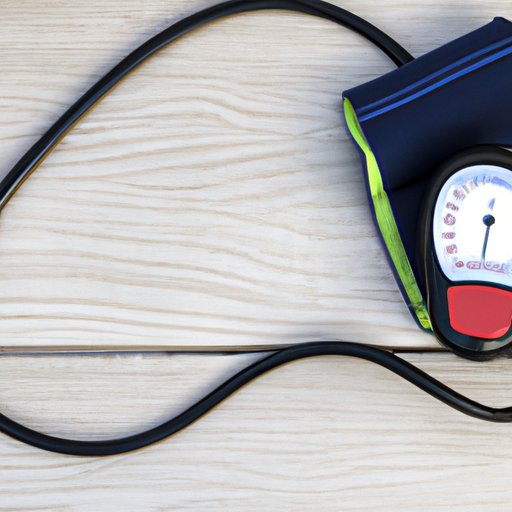Introduction
High blood pressure, also known as hypertension, is a common health condition that affects millions of people around the world. It occurs when the force of the blood against the walls of the arteries is too high, which can lead to an increased risk of stroke, heart attack, and other serious health problems. Fortunately, there are many ways to manage hypertension, including exercise.
Exercise has long been recognized as a powerful tool in the fight against high blood pressure. Regular physical activity can reduce the strain on the heart, improve overall health, and reduce the risk of other conditions associated with hypertension. In this article, we’ll explore how exercise can help manage high blood pressure, the role it plays in managing hypertension, and how to create an effective exercise plan to combat the condition.
Examining the Benefits of Exercise for High Blood Pressure Patients
The benefits of exercise for those with high blood pressure are numerous. Regular physical activity can help improve overall health, reduce stress, and improve quality of life. Exercise can also reduce the risk of developing other conditions associated with hypertension, such as diabetes, heart disease, and stroke.
In addition to the physical benefits, exercise can also have psychological benefits for those with high blood pressure. Regular physical activity can help to reduce stress levels, improve sleep, and boost mood. This can be especially beneficial for those who suffer from anxiety or depression as a result of their condition.

Exploring How Exercise Can Lower Blood Pressure
Regular physical activity is essential for those with high blood pressure. Aerobic exercise is especially beneficial as it increases heart rate and helps to strengthen the heart muscle. Examples of aerobic exercises include walking, jogging, cycling, swimming, and dancing. Resistance training is another great way to lower blood pressure as it helps to build strength and increase muscular endurance.
These types of exercise can help to reduce the strain on the heart and improve the overall health of those with hypertension. By engaging in regular physical activity, individuals with high blood pressure can lower their blood pressure and reduce their risk of other associated health issues.
The Role of Exercise in Managing Hypertension
Exercise can play a key role in managing hypertension. Maintaining a healthy weight is essential for those with high blood pressure as excess weight puts additional strain on the heart. Regular physical activity can help to keep weight down and reduce the risk of developing other conditions associated with hypertension.
Exercise can also help to reduce stress levels, which is important for those with hypertension. Stress can cause an increase in blood pressure, so engaging in regular physical activity can help to reduce stress and improve overall health.
Finally, exercise can help to improve sleep quality. Poor sleep can increase the risk of developing hypertension, so by improving sleep quality through regular physical activity, individuals with high blood pressure can reduce their risk of developing the condition.

Creating an Exercise Plan to Combat High Blood Pressure
It is important to create a tailored exercise plan to ensure that individuals with high blood pressure get the most out of their physical activity. This should include developing an appropriate exercise program that meets individual needs, setting realistic goals, and incorporating lifestyle changes to support the exercise plan.
When creating an exercise plan, it is important to consider the type of exercise that will be most beneficial for high blood pressure. Low-impact activities such as walking, swimming, and cycling are ideal as they put less strain on the heart. It is also important to start with shorter sessions and gradually increase the duration and intensity of the exercise over time.

Understanding the Link Between Exercise and High Blood Pressure
The link between exercise and high blood pressure is undeniable. Regular physical activity can help to reduce the strain on the heart, improve overall health, and reduce the risk of other conditions associated with hypertension. However, it is important to understand the potential risks of excessive exercise.
For those with high blood pressure, it is important to not overdo it. Excessive exercise can put additional strain on the heart and can even lead to an increase in blood pressure. Therefore, it is important to speak to a doctor before beginning an exercise program to ensure that it is safe and appropriate.
Combating High Blood Pressure Through Physical Activity
Regular physical activity is one of the most effective ways to lower blood pressure. The American Heart Association recommends at least two and a half hours of moderate-intensity physical activity per week for adults, or one hour and fifteen minutes of vigorous-intensity physical activity per week. Here are some tips for staying active:
- Make time for physical activity every day.
- Break up activity into smaller chunks throughout the day.
- Choose activities you enjoy.
- Set aside time to exercise with friends or family.
- Schedule physical activity into your daily routine.
Conclusion
Exercise is an important part of managing high blood pressure. Regular physical activity can reduce the strain on the heart, improve overall health, and reduce the risk of other conditions associated with hypertension. Exercise can also help to reduce stress, improve sleep quality, and maintain a healthy weight. Those with high blood pressure should create an appropriate exercise plan, set realistic goals, and incorporate lifestyle changes to support their plan.
By understanding the benefits and potential risks of exercise for high blood pressure, individuals can make informed decisions about their physical activity and take steps to combat their condition through physical activity. So, if you have high blood pressure, don’t hesitate to start an exercise program – it could be the best decision you ever make.


